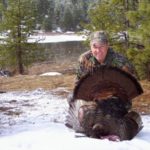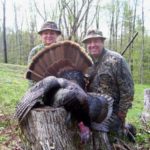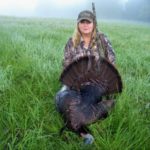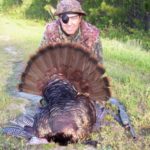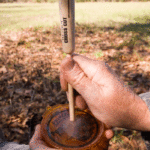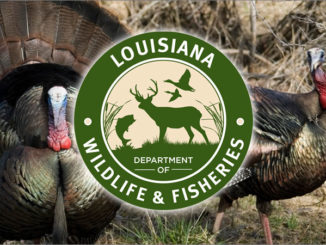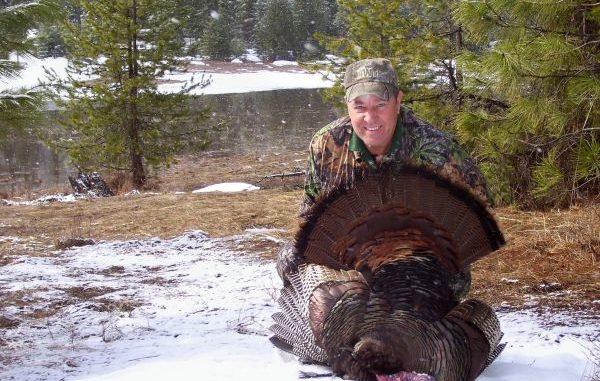
When Franklinton’s Randy Stafford hits your state, the odds are strong he’s going to reduce your turkey population.
If Alaska had a huntable population of turkeys, Franklinton’s Randy Stafford wouldn’t be stuck on having killed a turkey in 49 out of 50 states.
As it stands, though, the current Louisiana State Chapter President for the National Wild Turkey Federation is kind of glad he doesn’t have to travel to Alaska because that means he has more time to help his wife Debbie reach the same goal he has accomplished.
“She has killed a turkey in 26 states at present,” Stafford said recently during a conversation at H&H Gun Shop and Hunting Supply in the middle of the sleepy little town he calls home. “I completed my 49-Slam on May 14, 2010, in Pennsylvania, shooting left-handed because I had a patch over my right eye. Now we’re working on her 49-Slam.”
Killing a turkey is hard enough, but killing a turkey in 49 out of 50 states brings with it an extra measure of experience that makes one want to listen as if Stafford were the hunting equivalent of E.F. Hutton.
In other words, Stafford has enough skins on the wall, or maybe feathers in his cap, to command an audience intent on learning how to kill turkeys.
“We’ve had some remarkable journeys across the country,” he said. “We’ve started out all the way in California and wound up in Maine in some years, and that’s a full hunting trip. And the one thing that has stood out to me along the way is that people in Louisiana are hunting the hardest turkeys there are to hunt anywhere in the nation.”
Adding that Mississippi and Alabama birds were just as wary as Louisiana birds, Stafford explained that we’ve got the best turkey hunters combined with the most hunting pressure.
“Dumb birds don’t live long,” he quipped. “If you can kill birds down here, you can kill birds anywhere in the country.”
Understand public vs. private turkeys
“I think we have two different species of turkeys in Louisiana,” said Stafford. “We’ve got private-land turkeys and public-land turkeys.
“It’s strange, but it’s almost like the public-land turkeys have some kind of mechanism in their voices that don’t let them gobble but once a day.”
Stafford believes this same vow of silence can sometimes be found on big hunting clubs where there is just as much pressure as on public land. Whether public or a big club, there is only so many times a bird will gobble for somebody riding down a gravel road stopping every 100 yards to call out a few yelps.
“On the other hand, your private-land turkeys in Louisiana are a pleasure to hunt,” Stafford said. “Birds on private land do what turkeys are supposed to do, and they tend to be very vocal.”
Novices sometimes call too much
Stafford passed along that one of the worst things beginning turkey hunters do that does more harm than good is to call too much — and call too poorly.
“A cluck, purr and yelp — that’s the only thing (a beginning turkey hunters) needs to know how to do,” he said. “If you want to get into complicated calling like cackling, cutting and stuff like that, practice it in your car or at home where it will probably drive your wife nuts.”
One suggestion Stafford made that can help beginning turkey callers tremendously is to use one of the push-button calls like the Knight & Hale Tom Coffin call. Calls like these allow novice callers to create mistake-free sounds with a simple push-pull motion.
“You can cluck, purr and yelp with these push-button calls, and that’s all a beginning hunter needs to mess with,” Stafford added. “You can’t go wrong with any of those three made with one of these calls.”
Find where he roosts
This one seems simple enough, but I thought about how many times I have flushed turkeys from the roost while walking in to the deer stand without giving it much thought after my initial shock wore off.
“The best thing is to go out in the morning right before daylight at gobble time and listen to where they’re at,” Stafford recommended. “You can also hear them in the afternoon sometimes on private land either right before they fly up to roost or right after they get there.”
Stafford says that turkeys generally like to roost over some kind of water feature like an old slough or a wet area in a hollow, and that birds can roost in two or three different places over time.
“They fly up and roost over here and kind of go back and forth,” Stafford said. “That’s not to say they won’t roost in the same tree every night, but think about it logically: They’re always bugging and looking for food, so as they do this every day, the food’s going to decrease, and they’re going to have to move.”
Find where he flies down
Most of the time, turkeys will fly down right under where they roost, but Stafford says sometimes a bird strutting around in a pasture may get up and fly several hundred yards back into the woods.
“And it’s not uncommon for them to pitch out and sail all the way down into a field a hundred yards away where they feel safe,” he said. “Most of the time, it’s going to be a little food plot or an opening in the woods.”
Finding where turkeys fly down requires time in the woods, according to Stafford. The key is to get out there in the morning, not so close that you spook the birds, but close enough to know they’re there and can hear them once they get on the ground.
“After he moves off, get up there where he was and look around,” Stafford suggested. “Look around and see if there is an open spot there. If there is, that’s more than likely where he flew down. They don’t like thickets because of predators. They like to sit there and see there’s no danger out there.”
Stafford added that if a gobbler has hens with him, he will let them fly down first to check everything out and to look for boogers, and then he’ll fly down right in the middle of them.
Kill him when he hits the ground
“Once you figure out where he’s roosting and where he’s flying down, get in there before daylight and get set up with the landing zone between you and where he’s roosting,” Stafford advised. “You don’t want to get in there between the roost and his landing zone because he’s going to fly over your head then, and that increases your odds of being detected.”
Getting set up before daylight gives you the best chance to get set up properly because it’s hard to spook a turkey in the pre-dawn. We’re the noisiest things in the woods, but they hear all kinds of things moving around under them in the dark.
“If it’s light and you go in there trying to get too close, that gobbler is more than likely not the only turkey there,” Stafford said. “If his hens are close by, they’ll bust you as you’re moving in on the gobbler.”
Ideally, you should be set up so that he should be in sight and in gun range when his feet hit the ground, according to Stafford. If getting close enough to his landing area is not a possibility, then you’re probably not going to kill him at fly down.
Call him to you
If you can’t get on a turkey close enough to kill him when he flies down, Stafford suggests then trying to call to him. If you yelp and don’t even get finished before he cuts you off, that’s what you want to hear.
“If you call, and he waits 45 seconds to a minute before he gobbles, then he isn’t really interested in you,” he went on, “and he isn’t turned on at the moment.
“You can do some different things to try to make him get turned on — cut and cackle at him a lot of times. That can get him fired up, but more than likely if he’s got hens with him he’s not going to come to you.”
Stafford says that turkeys will frequently fly down with hens and breed a few that then feed on and off for a little while and go lay an egg. What you hope for is that they all leave, and he’s by himself.
“That’s when he’s vulnerable and you can kill that turkey,” Stafford said. “Man, I love to find a turkey by himself because he’ll respond, and he’ll come looking for that hen when he doesn’t have what he wants. That’s the kind of turkey you can set up on and call in.”
Get in front of him
If a turkey starts following hens and they all go somewhere, make mental notes of where that turkey went and follow him if you have to. If you’ve got the time, you can come back later and set up differently, but if you don’t have time to do that, you’ve got to get in front of him.
“Ninety-five percent of killing a turkey is being where he wants to go,” Stafford said. “Changing his mind and bringing him back over is especially hard if he’s following hens.
“If I follow a turkey and discover that he headed over to another opening in another field — say a clover patch or something — the next time I’m in there hunting and he does that, I’m going over there where he wants to go. Or I may not even fool with him on the roost and fly-down. I’m going to get where he wants to go.”
Find the strut zones
A lot of old birds won’t gobble at fly-down. They’ll simply service the hens and then head off to a place called a strut zone. Perhaps it’s a spot on a ridge with an opening on it. Maybe it’s a flat down in a bottom. Whatever it is, he goes there every day and just sits there and gobbles every once in a while.
“The hens know this is where he’s hanging out, and when they want to get with him they know where to go,” Stafford explained. “He may not do anything but sit there and strut and drum all day long. And this is good for public land because even if they don’t gobble they’re going to strut and drum.”
Try different kinds of the same call
Learning when to use which call is hard to do, and Stafford says this is the kind of knowledge that can only be learned from years and years of turkeys telling you what they like and what they don’t by how they respond.
“But one thing I like to do is carry two different box calls, a couple different slate calls and some different mouth calls,” Stafford said. “I’ve been places where I can make the best sound come out of one box and nothing. I pick up another box and that sucker will blow my brains out when he responds.”
In other words, turkeys can respond to different sounds made by different kinds of the same call. Stafford joked that maybe a bird that does this might have had an old girlfriend that sounded like the one that gets his attention, and that’s what turns him on.
